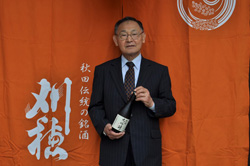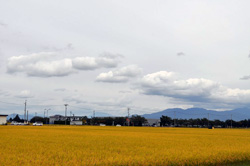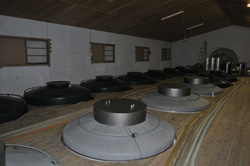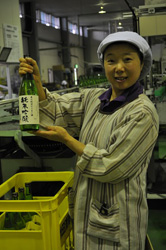Meet Japanese Companies with Quality
AKITA SEISHU CO., LTD.
Website: AKITA SEISHU CO., LTD.![]()
Category: Japanese Food
Intimately local
Surrounded by green, rolling hills and clear, flowing water with pale green and amber rice paddies stretching into the distance, Daisen City in Akita Prefecture is a sight to behold. The Ito family has lived in Akita for 400 years, and the prefecture has a long, rich history as a rice-growing region. The Itos harvested rice and in 1865, Jushiro Ito began using part of their crop to brew nihonshu, or “sake.” Now led by sixth generation CEO Yohei Ito, Akita Seishu Co. Ltd. makes and bottles nihonshu using Akita rice under the Dewatsuru, Kariho and Yamato Shizuku brands.

Fifth generation Chairman CEO Tatsuro Ito in front of the Kariho brewery

Akita rice ripening in early autumn
Tradition and dedication
At Akita Seishu, nihonshu is a seasonal pursuit. Rice is planted, grown and harvested from spring to autumn. It’s during the long winter that the harvested rice is used to make nihonshu. The same people who grow the rice also brew the sake, so brewers have their hands on the product from when the seeds are planted until the product is bottled.
Though its two breweries are only a few kilometers apart, each uses different water, which has a strong effect on the flavors. The Kariho brand has a more mineral-heavy water source, creating a drink characterized by a drier, sharper taste. The top seller, the Kariho Daiginjo, has a lighter, clearer taste that’s reminiscent of the cold snap of Akita’s winter air.
The soft water from the Dewa Hills aquifer means that Dewatsuru nihonshu tends to be a gentler, milder drink. The Dewatsuru mark also includes a few certified organic sakes, including the Junmai Ginjo-shu, with a rich, semi-sweet taste that goes well with slightly heavier foods. And the Yamato Shizuku brand, which is also produced at the Dewatsuru site, is an exercise in hyper-local production: all ingredients are obtained within a 10-kilometer radius, with the water and rice both sourced in the immediate area.

Bottling Kariho sake at Akita Seishu brewery

A worker at the Akita Seishu bottling plant displays a bottle she is preparing for shipping
Growing popularity
Nihonshu has been making great inroads internationally in recent decades. Chairman and CEO Tatsuro Ito says Japanese people were more interested in whiskey and wine in the 1980s, while at the same time sake began gaining acceptance abroad. Ito first went to the U.S. in 1988 to promote Akita Seishu’s products and since then its appeal has grown.
The products are available in Europe and North America, and Akita Seishu is now targeting Southeast Asian countries such as Thailand and Malaysia. “There are 1,500 varieties of nihonshu in Japan, and when you drink it, you can understand something of the place it came from and the people who made it,” says Ito. Steeped in history, culture and hard work, Akita Seishu’s nihonshu is a little taste of northern Japan and a true symbol of Akita pride.
Website: AKITA SEISHU CO., LTD.![]()



